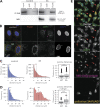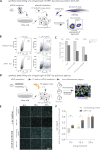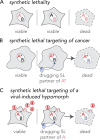Viral protein engagement of GBF1 induces host cell vulnerability through synthetic lethality
- PMID: 36305789
- PMCID: PMC9623979
- DOI: 10.1083/jcb.202011050
Viral protein engagement of GBF1 induces host cell vulnerability through synthetic lethality
Abstract
Viruses co-opt host proteins to carry out their lifecycle. Repurposed host proteins may thus become functionally compromised; a situation analogous to a loss-of-function mutation. We term such host proteins as viral-induced hypomorphs. Cells bearing cancer driver loss-of-function mutations have successfully been targeted with drugs perturbing proteins encoded by the synthetic lethal (SL) partners of cancer-specific mutations. Similarly, SL interactions of viral-induced hypomorphs can potentially be targeted as host-based antiviral therapeutics. Here, we use GBF1, which supports the infection of many RNA viruses, as a proof-of-concept. GBF1 becomes a hypomorph upon interaction with the poliovirus protein 3A. Screening for SL partners of GBF1 revealed ARF1 as the top hit, disruption of which selectively killed cells that synthesize 3A alone or in the context of a poliovirus replicon. Thus, viral protein interactions can induce hypomorphs that render host cells selectively vulnerable to perturbations that leave uninfected cells otherwise unscathed. Exploiting viral-induced vulnerabilities could lead to broad-spectrum antivirals for many viruses, including SARS-CoV-2.
© 2022 Navare et al.
Figures







Update of
-
Viral protein engagement of GBF1 induces host cell vulnerability through synthetic lethality.bioRxiv [Preprint]. 2020 Nov 6;221(11):2020.10.12.336487. doi: 10.1101/2020.10.12.336487. bioRxiv. 2020. Update in: J Cell Biol. 2022 Nov 7;221(11):e202011050. doi: 10.1083/jcb.202011050. PMID: 33173868 Free PMC article. Updated. Preprint.
Similar articles
-
Viral protein engagement of GBF1 induces host cell vulnerability through synthetic lethality.bioRxiv [Preprint]. 2020 Nov 6;221(11):2020.10.12.336487. doi: 10.1101/2020.10.12.336487. bioRxiv. 2020. Update in: J Cell Biol. 2022 Nov 7;221(11):e202011050. doi: 10.1083/jcb.202011050. PMID: 33173868 Free PMC article. Updated. Preprint.
-
A Redundant Mechanism of Recruitment Underlies the Remarkable Plasticity of the Requirement of Poliovirus Replication for the Cellular ArfGEF GBF1.J Virol. 2019 Oct 15;93(21):e00856-19. doi: 10.1128/JVI.00856-19. Print 2019 Nov 1. J Virol. 2019. PMID: 31375590 Free PMC article.
-
The development of resistance to an inhibitor of a cellular protein reveals a critical interaction between the enterovirus protein 2C and a small GTPase Arf1.PLoS Pathog. 2023 Sep 18;19(9):e1011673. doi: 10.1371/journal.ppat.1011673. eCollection 2023 Sep. PLoS Pathog. 2023. PMID: 37721955 Free PMC article.
-
Poliovirus replication requires the N-terminus but not the catalytic Sec7 domain of ArfGEF GBF1.Cell Microbiol. 2010 Oct;12(10):1463-79. doi: 10.1111/j.1462-5822.2010.01482.x. Cell Microbiol. 2010. PMID: 20497182 Free PMC article.
-
Involvement of cellular membrane traffic proteins in poliovirus replication.Cell Cycle. 2007 Jan 1;6(1):36-8. doi: 10.4161/cc.6.1.3683. Epub 2007 Jan 11. Cell Cycle. 2007. PMID: 17245115 Review.
Cited by
-
Exploiting host kinases to combat dengue virus infection and disease.Antiviral Res. 2025 Sep;241:106172. doi: 10.1016/j.antiviral.2025.106172. Epub 2025 May 8. Antiviral Res. 2025. PMID: 40348023 Review.
-
Discovery of host-directed modulators of virus infection by probing the SARS-CoV-2-host protein-protein interaction network.Brief Bioinform. 2022 Nov 19;23(6):bbac456. doi: 10.1093/bib/bbac456. Brief Bioinform. 2022. PMID: 36305426 Free PMC article.
-
Predicting host-based, synthetic lethal antiviral targets from omics data.NAR Mol Med. 2024 Jan 23;1(1):ugad001. doi: 10.1093/narmme/ugad001. eCollection 2024 Jan. NAR Mol Med. 2024. PMID: 38994440 Free PMC article.
-
Synthetic lethality-based prediction of anti-SARS-CoV-2 targets.iScience. 2022 May 20;25(5):104311. doi: 10.1016/j.isci.2022.104311. Epub 2022 Apr 27. iScience. 2022. PMID: 35502318 Free PMC article.
-
Predicting host-based, synthetic lethal antiviral targets from omics data.bioRxiv [Preprint]. 2023 Aug 16:2023.08.15.553430. doi: 10.1101/2023.08.15.553430. bioRxiv. 2023. Update in: NAR Mol Med. 2024 Jan 23;1(1):ugad001. doi: 10.1093/narmme/ugad001. PMID: 37645861 Free PMC article. Updated. Preprint.
References
-
- Beijersbergen, R.L., Wessels L.F.A., and Bernards R.. 2017. Synthetic lethality in cancer therapeutics. Annu. Rev. Cancer Biol. 1:141–161. 10.1146/annurev-cancerbio-042016-073434 - DOI
Publication types
MeSH terms
Substances
Grants and funding
LinkOut - more resources
Full Text Sources
Molecular Biology Databases
Miscellaneous

